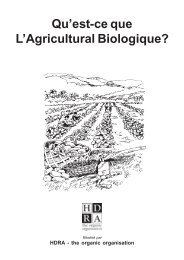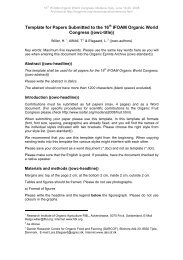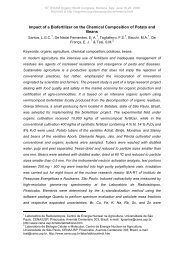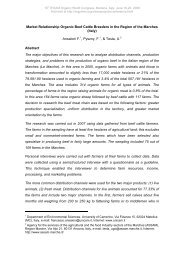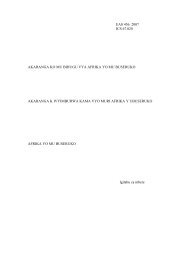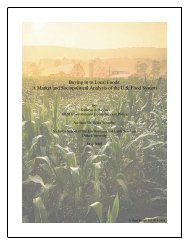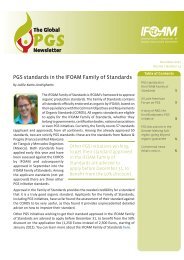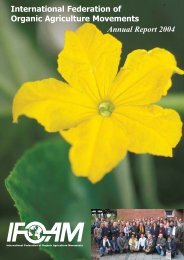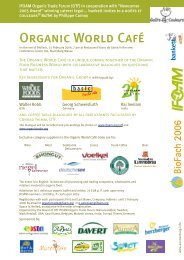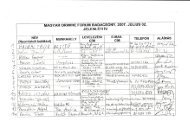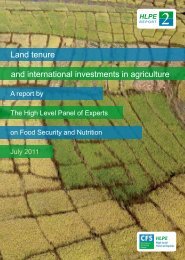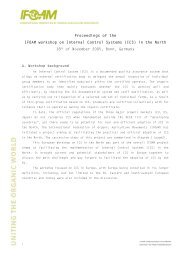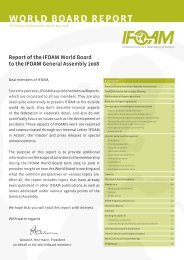FiBL presentation - Urs Niggli - ifoam
FiBL presentation - Urs Niggli - ifoam
FiBL presentation - Urs Niggli - ifoam
Create successful ePaper yourself
Turn your PDF publications into a flip-book with our unique Google optimized e-Paper software.
Research Institute of Organic Agriculture<br />
Forschungsinstitut für biologischen Landbau<br />
Institut de recherche de l�agriculture biologique<br />
The concept of eco-functional<br />
intensification for agricultural<br />
research<br />
Prof Dr <strong>Urs</strong> <strong>Niggli</strong>
<strong>FiBL</strong>, involved in organic food and farming<br />
system research since 1974<br />
www.fibl.org<br />
135 staff in Switzerland<br />
20 staff in Germany<br />
15 staff in Austria<br />
~ 70 trainees and students
Eco-functional intensification<br />
www.fibl.org
Summary of positive effects of organic farming<br />
on biodiversity (< 200 papers).<br />
30 % higher species diversity and a 50 % greater<br />
abundance of arthropods (insects, beetles etc.) in organic<br />
fields, especially predators and parasitoids.<br />
Organic farming benefits pollinators: domestic<br />
honeybees, wild bees, butterflies, bumblebees,<br />
other insects and bats.<br />
Soils: Earthworms, soil dwelling arthropods<br />
and soil bacteria, fungi and Mycorrhiza<br />
considerably increased.<br />
Birds: considerably more breeding territories,<br />
higher population densities, higher number of<br />
offspring reared.<br />
High diversity of the segetal flora in arable<br />
systems.<br />
www.fibl.org<br />
Hole et al., 2005; <strong>Niggli</strong>, 2010
Multi-level biodiversity<br />
Diversity of landscapes<br />
www.fibl.org<br />
Diversity of species<br />
Risk management<br />
of organic/low-input farms<br />
Diversity of structures/habitats<br />
Diversity of crops or varieties
Companion plants to enhance beneficials in the<br />
field<br />
Companion plants serve as food sources within the crop to enhance<br />
longevity and oviposition of parasitoids.<br />
www.fibl.org<br />
Parasitoids: from<br />
2 day survival in<br />
cabbage (mono)<br />
to 20 days in<br />
cabbage +<br />
cornflower<br />
Génau, 2010, <strong>FiBL</strong>
Companion plants to enhance beneficials in the<br />
field<br />
www.fibl.org<br />
Génau, 2010, <strong>FiBL</strong>
mean number/tree<br />
mean number/tree<br />
Less aphids, more beneficials<br />
15<br />
10<br />
5<br />
0<br />
80<br />
60<br />
40<br />
20<br />
0<br />
Dysaphis plantaginea<br />
Apr. May Jun. Jul. Aug. Sep. Oct.<br />
Potential prey for spiders<br />
Apr. May Jun. Jul. Aug. Sep. Oct.<br />
Development of rosy apple aphid, potential prey, spiders, and predators<br />
in strip-managed part or control part of an apple orchard<br />
www.fibl.org<br />
mean number/tree<br />
mean number/tree<br />
15<br />
10<br />
5<br />
0<br />
6<br />
4<br />
2<br />
0<br />
Aphid predators<br />
Apr. May Jun. Jul. Aug. Sep. Oct.<br />
Spiders<br />
Apr. May Jun. Jul. Aug. Sep. Oct.<br />
Wyss, <strong>FiBL</strong>, 1995
Utilize ecosystem services for long-term<br />
sustainable productivity<br />
PGPR (Plant growthpromoting<br />
rhizobacteria)<br />
www.fibl.org<br />
Ground beetles<br />
(Carabides)<br />
Mycorrhizal fungi
Soil fertility in a 34 year field experiment (CH)<br />
A Physical<br />
Bulk<br />
density<br />
C Microbial<br />
Mycorrhiza<br />
Saccharase<br />
Percolation<br />
stability<br />
150<br />
100<br />
50<br />
0<br />
Microbial<br />
biomass<br />
200<br />
100<br />
0<br />
Phosphatase<br />
Aggregate<br />
stability<br />
Dehydrogenase<br />
Protease<br />
B Chemical<br />
Magnesium<br />
Calcium<br />
D Faunal<br />
Spiders<br />
Staphilinids<br />
BIODYN<br />
pH<br />
150<br />
CONFYM<br />
BIOORG CONMIN<br />
www.fibl.org Mäder et al., 2002, Science, 296<br />
100<br />
50<br />
0<br />
Potassium<br />
Earthworm<br />
biomass<br />
200<br />
100<br />
0<br />
Organic<br />
carbon<br />
Phosphorus<br />
Carabids<br />
Earthworm<br />
abundance
Resource use efficiency (DOK trial, 28 years)<br />
Parameter Unit Organic<br />
farming<br />
www.fibl.org<br />
Integrated<br />
farming (IP)<br />
with FYM<br />
Organic<br />
in %<br />
of IP<br />
Nutrient input kg N total ha -1 yr -1 101 157 64 %<br />
kg N min ha -1 yr -1 34 112 30 %<br />
kg P ha -1 yr -1 25 40 62 %<br />
kg K ha -1 yr -1 162 254 64 %<br />
Pesticides applied kg ha -1 yr -1 1.5 42 4 %<br />
Fuel use L ha -1 yr -1 808 924 87 %<br />
Total yield output<br />
for 28 years % 83 100 83 %<br />
Soil microbial<br />
biomass �output� tons ha -1 40 24 167 %<br />
Mäder, Fliessbach, <strong>Niggli</strong> (2002), Science 296
Organic = best adaptation to climate change<br />
due to higher soil carbon levels<br />
Increased aggregate stability (Gerhardt, 1997; Siegrist et al.,<br />
1998; Brown et al., 2000; Maeder et al., 2002; Pulleman et al., 2003;<br />
Williams & Petticrew, 2009).<br />
Increased water holding capacity, higher water<br />
content in soil (Brown et al., 2000; Lotter et al., 2003; Pimentel et<br />
al., 2005)<br />
Improved infiltration<br />
rate of water<br />
(Lotter et al., 2003;<br />
Pimentel et al., 2005;<br />
Zeiger & Fohrer, 2009).<br />
www.fibl.org
Meta-analysis of 44* long-term field<br />
experiments: soil carbon under organic<br />
farming<br />
North America<br />
www.fibl.org<br />
* meanwhile data from 62 studies<br />
Gattinger et al. in prep
How much Carbon is stored under OF?<br />
www.fibl.org<br />
N = 47 N = 71<br />
a b<br />
Mean duration of<br />
experiments: 16 years<br />
Differences<br />
horticulture>grassland>arable<br />
crops<br />
37.4 Mg C/ha<br />
26.7 Mg C/ha<br />
10.7 Mg C/ha (=metric tons)<br />
Gattinger et al. in prep
Habitat and species diversity<br />
Vascular<br />
plants<br />
www.fibl.org<br />
Forests Grassland Fields Human<br />
settlements<br />
Alpine<br />
pasture<br />
Mountains<br />
21 +/- 1 35 +/- 1 15 +/- 1 19 +/- 3 42 +/- 3 21 +/-<br />
Mosses 15 +/- 1 6 +/- 1 1 +/- 0 5 +/- 1 19 +/- 2 13 +/- 1<br />
Snails 9 +/- 1 6 +/- 0 3 +/- 1 6 +/- 1 3 +/- 1 3 +/- 1<br />
Average number of species on an area of ten square meters. «Mountains� include areas not used for<br />
alpine grazing (such as scree plant communities, turf, and dwarf shrub heath), but exclude glaciers and<br />
inaccessible rocks. Source: BDM
Robust, dual-purpose breeds are needed to<br />
scope efficiently with the diversity of grassland<br />
For dairy breeds, meat<br />
must be produced<br />
additionally through<br />
suckler cows.<br />
This aspect is often<br />
neglected.<br />
www.fibl.org<br />
Methane emission (kg) per<br />
inhabitant from<br />
Breed Milk Meat Sum<br />
Holstein 5.0 9.0 14.0<br />
Simmental 6.0 5.8 11.8<br />
Based on Rosenberger et al., 2004
Control of endoparasites of livestock<br />
www.fibl.org<br />
Pasture management<br />
Biocontrol with the fungus<br />
Duddingtonia flagrans<br />
Variation in genetic tolerance?<br />
Fooder crops like Chicory<br />
and Sainfoin (Esparsette)<br />
Heckendorn, <strong>FiBL</strong>, 2010
Cultivar mixtures and plant health<br />
www.fibl.org<br />
% of apples with scab lesions<br />
Apple cultivars 1997 1999 2000<br />
Golden Delicious mono 41% 66% 20%<br />
Golden Delicious+Rewena 22% 34% 3%<br />
Golden Delicous+Pinova+Elstar 9% 27% 1%<br />
Golden Delicous+Rewena+Ariwa 9% 19% 1%<br />
Gessler et al., 2003
Participatory plant breeding programs:<br />
specially suited for organic farms<br />
www.fibl.org
Different approaches to sustainability<br />
Improved technologies like minimum/ no tillage or GMO<br />
crops.<br />
Integrated Production (IP, IPM).<br />
Low Input Agriculture (LIA) or Precision<br />
Farming.<br />
Low External Input Sustainable<br />
Agriculture (LEISA).<br />
Organic Farming<br />
Organic plus innovative elements<br />
of low till, precision farming and LEISA.<br />
Organic (successional) agroforestry systems<br />
www.fibl.org




